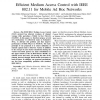116
Voted
ITIIS
2010
14 years 7 months ago
2010
IEEE 802.11 medium access control (MAC) employs the distributed coordination function (DCF) as the fundamental medium access function. DCF operates with binary exponential backoff...
112
click to vote
CORR
2011
Springer
14 years 7 months ago
2011
Springer
: We study a simple general scenario of ad hoc networks based on IEEE 802.11 wireless communications, consisting in a chain of transmitters, each of them being in the carrier sense...
127
Voted
Publication
To improve the already tarnished reputation of WLAN security, the new IEEE 802.11i security standard provides means for an enhanced user authentication and strong data confidential...
136
Voted
ICWN
2009
14 years 10 months ago
2009
The IEEE 802.11 Medium Access Control (MAC) protocol has inherent weakness of channel wastage while operating a Mobile Ad hoc Network (MANET). In this paper, we therefore propose s...
121
Voted
GLOBECOM
2010
IEEE
14 years 10 months ago
2010
IEEE
Abstract--Wireless mesh networks (WMNs) are wireless multihop networks comprised of mesh routers, which relay traffic on behalf of clients and other nodes. Using the standard IEEE ...
115
click to vote
VTC
2010
IEEE
14 years 11 months ago
2010
IEEE
Abstract—The IEEE 802.11 wireless LAN (WLAN) is a timetested technology, but it is still evolving towards even higher speeds and richer features. For multi-room IPTV delivery, wh...
128
click to vote
TMC
2002
15 years 7 days ago
2002
Abstract--Link adaptation to dynamically select the data transmission rate at a given time has been recognized as an effective way to improve the goodput performance of the IEEE 80...
122
Voted
ADHOC
2004
15 years 14 days ago
2004
The IEEE 802.11 standard for medium access control in wireless local area networks has been adopted as the de-facto medium access control standard in multi-hop wireless networks. I...
104
click to vote
JNW
2007
15 years 14 days ago
2007
—Performance of IEEE 802.11 distributed coordination function (DCF) has been studied by several authors under steady-state conditions. Behavior of DCF under transient state condi...
100
Voted
TMC
2008
15 years 14 days ago
2008
Under a multirate network scenario, the IEEE 802.11 DCF MAC fails to provide airtime fairness for all competing stations since the protocol is designed for ensuring max-min through...




